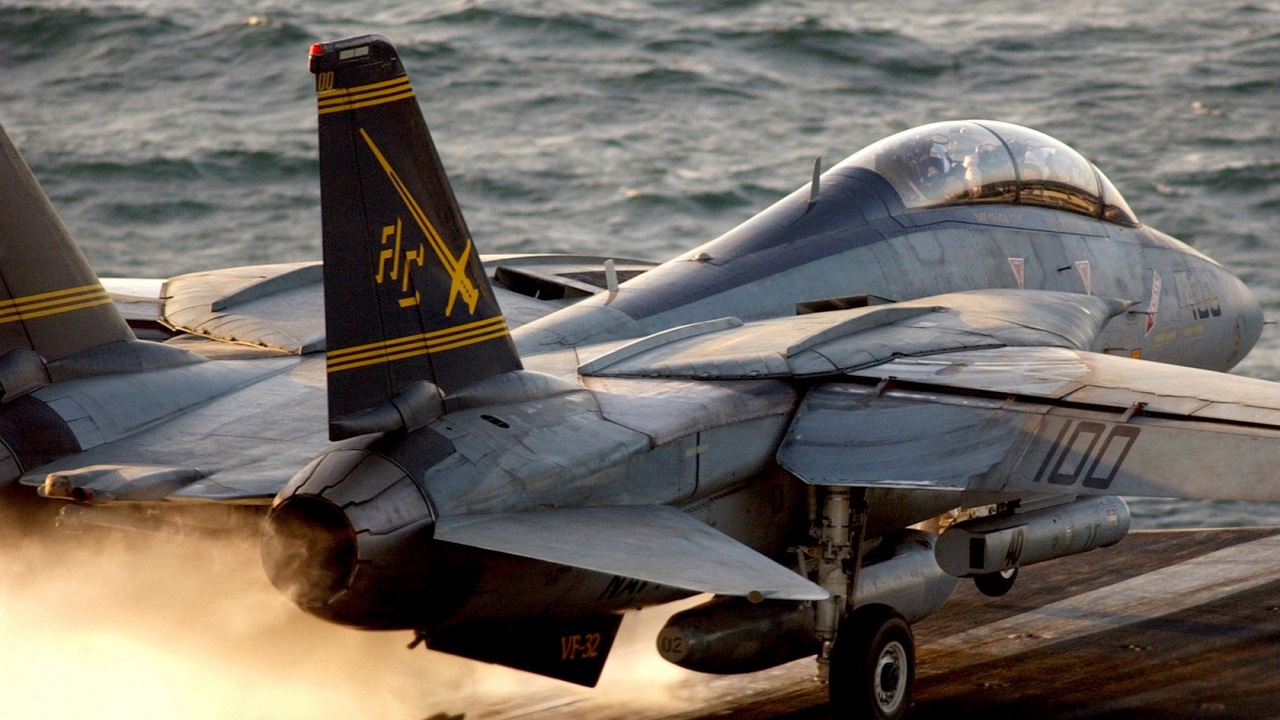Thanks to the Top Gun movies, the F-14 Tomcat might just be the most famous fighter plane ever to fly. And yet, the general public does not know that the Tomcat did have its share of problems and was not perfect. Oh, and that the plane also flies for Iran. One expert breaks down the F-14 and its complicated history below: The F-14 is one of the U.S. Navy’s most iconic and recognizable airplanes. It zoomed into public consciousness after the first Top Gun movie in 1986. Versatile and maneuverable, it became a workhorse for the navy. But people forget that it had a fatal flaw. The engines were subpar, resulting in several tragic mishaps. Some of the flawed power plants still lived on in F-14s until the Tomcat was retired in 2006.
Let’s take a closer look at the story of the F-14’s main drawback.
First Woman F-14 Pilot Was a Casualty
Originally, the F-14 was powered by two Pratt & Whitney TF30 engines. They had ample thrust but were unpredictable and sensitive. Problems cropped up when the airplane approached a carrier to land and when the fighter flew low and slow. One of the main focusing events of the F-14’s troubles was when the first woman pilot to fly a Tomcat died in a 1994 crash that was attributed to engine failure. Lt. Kara Hultgreen was trying to land on the USS Abraham Lincoln when she lost an engine 50 miles from San Diego. When the Tomcat rolled over, Hultgreen ejected into the ocean before the airplane hit the water and she didn’t survive.
Engine Problems Were Well-Known in the Navy and Among Lawmakers
Congress, especially the vociferous Senator John McCain, called for an investigation into the TF30 engines. Admirals familiar with the F-14 saga, especially the early F-14A, drew a direct line to the power plants and their troubles.
Retired Rear Admiral John Christiansen, who worked for the Grumman Aircraft that built the F-14A, told the Chicago Tribune at the time that the “critical engine problems” came from “stress corrosion in first stage fan blades, excessive vibration in second to third stage fan air seal, and insufficient fan case strength to contain internal failures.” This led to compressor stalls that caused the engines to fail. Some tried to sound the alarms as far back as 1984. Navy Secretary John F. Lehman Jr. said that the “TF30 engine is just a terrible engine and has accounted for 28.2 percent of all F-14 crashes.”
New Engines Could Not Come Fast Enough
While Congress called for change, Pratt & Whitney attempted to adjust the TF30 engines, but the failures continued to mount leading to the eventual destruction of 40 Tomcats with many of the crashes attributed to the defective power plants.
Some Tomcats Still Flew the Faulty TF30s
Engines on many of the Tomcats were finally swapped out beginning in 1987 with the General Electric F110-GE-400s. But several Tomcats still flew with the TF30s until the 2000s. Tragically the F-14 Hultgreen was flying seven years later and still had the TF30s installed.
By 1996, only 126 Tomcats had the GE engine.
Pilots Had No Choice But to Adjust
The pilots were aware of the problems and often overcompensated with caution and “flew the engine” instead of the airplane. This was going to be a hazard if the fighter ever entered into a dogfight against the Soviets.
Some thought the Tomcat should have just been relegated to launch stand-off missiles.
Pilots Practiced for Engine Failure
The pilots even rehearsed for engine hazards on the flight simulator. Naval aviators also watched video of crashes to ready themselves for any failure that might arise.
Pilot Steve Petro Petroski and radio intercept officer Dave Bio Baranek wrote an article in 2016 recalling a close call with the F-14 and it centered around the engines. Petroski recalled that “the greater concern, as all Tomcat crews could tell you, was the 9-foot distance between engine centerlines. We had all seen the mishap video of a cat shot where the pilot didn’t keep the nose down and the aircraft rolled. Two fatalities. It got the attention of the community and resulted in revised single-engine takeoff procedures. I guess that’s why I focused on the engine tapes. I was ready when it happened to me.”
So, you can see how the pilots rehearsed for engine failure. Aside from the engines, the F-14 was a capable airplane. It was particularly nimble with the variable sweeping wing system. It could track and engage multiple targets. The back seat radio intercept officer helped the pilot to maintain a laser-like focus on the job at hand. But the original engines were a problem that led to close calls, accidents, and deaths.
So, the F-14 had a smudge on an otherwise positive service record.
Now serving as 1945’s Defense and National Security Editor, Brent M. Eastwood, PhD, is the author of Humans, Machines, and Data: Future Trends in Warfare. He is an Emerging Threats expert and former U.S. Army Infantry officer. You can follow him on Twitter @BMEastwood.

